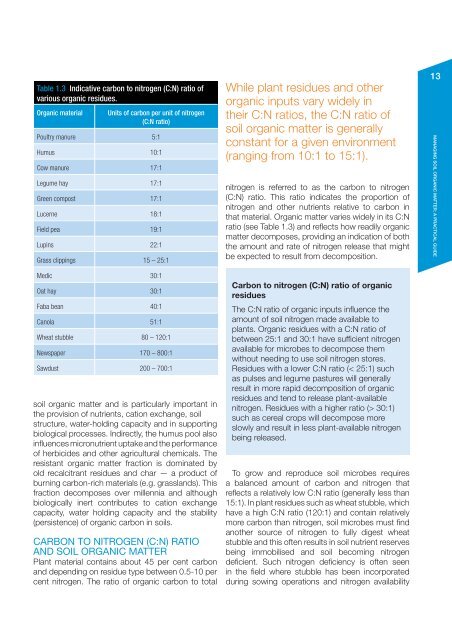managing soil organic matter - Grains Research & Development ...
managing soil organic matter - Grains Research & Development ...
managing soil organic matter - Grains Research & Development ...
You also want an ePaper? Increase the reach of your titles
YUMPU automatically turns print PDFs into web optimized ePapers that Google loves.
Table 1.3 Indicative carbon to nitrogen (C:N) ratio ofvarious <strong>organic</strong> residues.Organic materialUnits of carbon per unit of nitrogen(C:N ratio)Poultry manure 5:1Humus 10:1Cow manure 17:1Legume hay 17:1Green compost 17:1Lucerne 18:1Field pea 19:1Lupins 22:1Grass clippings 15 – 25:1Medic 30:1Oat hay 30:1Faba bean 40:1Canola 51:1Wheat stubble 80 – 120:1Newspaper 170 – 800:1Sawdust 200 – 700:1<strong>soil</strong> <strong>organic</strong> <strong>matter</strong> and is particularly important inthe provision of nutrients, cation exchange, <strong>soil</strong>structure, water-holding capacity and in supportingbiological processes. Indirectly, the humus pool alsoinfluences micronutrient uptake and the performanceof herbicides and other agricultural chemicals. Theresistant <strong>organic</strong> <strong>matter</strong> fraction is dominated byold recalcitrant residues and char — a product ofburning carbon-rich materials (e.g. grasslands). Thisfraction decomposes over millennia and althoughbiologically inert contributes to cation exchangecapacity, water holding capacity and the stability(persistence) of <strong>organic</strong> carbon in <strong>soil</strong>s.CARBON TO NITROGEN (C:N) RATIOAND SOIL ORGANIC MATTERPlant material contains about 45 per cent carbonand depending on residue type between 0.5-10 percent nitrogen. The ratio of <strong>organic</strong> carbon to totalWhile plant residues and other<strong>organic</strong> inputs vary widely intheir C:N ratios, the C:N ratio of<strong>soil</strong> <strong>organic</strong> <strong>matter</strong> is generallyconstant for a given environment(ranging from 10:1 to 15:1).nitrogen is referred to as the carbon to nitrogen(C:N) ratio. This ratio indicates the proportion ofnitrogen and other nutrients relative to carbon inthat material. Organic <strong>matter</strong> varies widely in its C:Nratio (see Table 1.3) and reflects how readily <strong>organic</strong><strong>matter</strong> decomposes, providing an indication of boththe amount and rate of nitrogen release that mightbe expected to result from decomposition.Carbon to nitrogen (C:N) ratio of <strong>organic</strong>residuesThe C:N ratio of <strong>organic</strong> inputs influence theamount of <strong>soil</strong> nitrogen made available toplants. Organic residues with a C:N ratio ofbetween 25:1 and 30:1 have sufficient nitrogenavailable for microbes to decompose themwithout needing to use <strong>soil</strong> nitrogen stores.Residues with a lower C:N ratio (< 25:1) suchas pulses and legume pastures will generallyresult in more rapid decomposition of <strong>organic</strong>residues and tend to release plant-availablenitrogen. Residues with a higher ratio (> 30:1)such as cereal crops will decompose moreslowly and result in less plant-available nitrogenbeing released.To grow and reproduce <strong>soil</strong> microbes requiresa balanced amount of carbon and nitrogen thatreflects a relatively low C:N ratio (generally less than15:1). In plant residues such as wheat stubble, whichhave a high C:N ratio (120:1) and contain relativelymore carbon than nitrogen, <strong>soil</strong> microbes must findanother source of nitrogen to fully digest wheatstubble and this often results in <strong>soil</strong> nutrient reservesbeing immobilised and <strong>soil</strong> becoming nitrogendeficient. Such nitrogen deficiency is often seenin the field where stubble has been incorporatedduring sowing operations and nitrogen availability13MANAGING SOIL ORGANIC MATTER: A PRACTICAL GUIDE
















